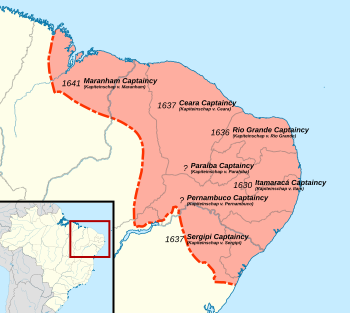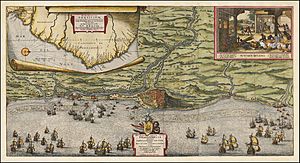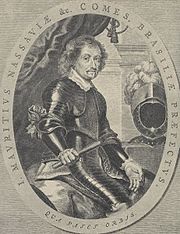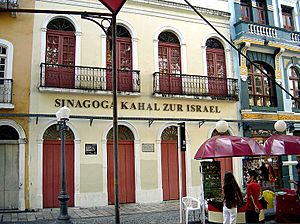Dutch Brazil facts for kids
Quick facts for kids
Dutch Brazil
Nederlands-Brazilië
|
|||||||||
|---|---|---|---|---|---|---|---|---|---|
| 1630–1654 | |||||||||
|
|
|||||||||

Map of Dutch Brazil from 1630-1654, overlayed on a modern-day map of Brazil.
|
|||||||||
| Status | Dutch colony | ||||||||
| Capital | Mauritsstad | ||||||||
| Common languages | Dutch Indigenous languages Portuguese |
||||||||
| Religion | Dutch Reformed (official), Catholicism, Indigenous American Beliefs, Judaism, African religions | ||||||||
| Government | Colony | ||||||||
| Governor | |||||||||
|
• 1637–1643
|
John Maurice, Prince of Nassau-Siegen | ||||||||
|
• 1643–1654
|
Dutch West India Company | ||||||||
| History | |||||||||
|
• Established
|
16 February 1630 | ||||||||
|
• Arrival of Maurice of Nassau
|
23 January 1637 | ||||||||
|
• First Battle of Guararapes
|
19 April 1648 | ||||||||
|
• Second Battle of Guararapes
|
19 February 1649 | ||||||||
|
• Defeat by the Portuguese
|
28 January 1654 | ||||||||
| Currency | Braziliaanse Guldens (Brazilian Guilders) | ||||||||
|
|||||||||
| Today part of | Brazil | ||||||||
Dutch Brazil (Dutch: Nederlands-Brazilië), also known as New Holland (Dutch: Nieuw-Holland), was a part of modern-day Brazil that was controlled by the Dutch Republic from 1630 to 1654. It was located in the northeastern part of Brazil. The main city and capital of this Dutch colony was Mauritsstad, which is now part of Recife. Other important cities included Frederikstadt (João Pessoa) and Nieuw Amsterdam (Natal).
The Dutch took control of almost half of Brazil's European-settled areas at the time. The Dutch West India Company (GWC) was in charge, with its main office in Recife. A famous governor, John Maurice of Nassau, invited artists and scientists to the colony. This helped make Brazil more known and encouraged people to move there. However, the Dutch lost control after a big defeat by the Portuguese in the Second Battle of Guararapes in 1649.
On January 26, 1654, the Dutch gave up their control. By May 1654, the Dutch Republic demanded that New Holland be returned. Finally, on August 6, 1661, the land was officially given back to Portugal through a peace agreement called the Treaty of The Hague. Even though Dutch rule was short, it was an important time in Brazil's history. It also caused problems for Brazil's important sugar industry, as the fighting made it hard to produce sugar.
Contents
Dutch and Portuguese Relations
For a long time, the Habsburg family ruled the Low Countries (where the Dutch lived). In 1556, this area became part of the Spanish Empire. However, in 1568, the Eighty Years' War began, and the Dutch fought for their independence. They formed the Republic of the Seven United Netherlands in 1581. During this war, Dutch ships attacked Spanish lands and colonies.
In 1594, Philip II, who was king of both Spain and Portugal, allowed Dutch ships to sail to Brazil once a year. From 1580 to 1640, Portugal was united with Spain under the same king. In 1609, the Dutch and the Habsburgs signed a peace agreement called the Twelve Years' Truce. This allowed the Dutch to trade with Portuguese settlements in Brazil. Portugal was a small country and needed help from other nations for its trade and colonies. The Dutch played a big role in this, which was good for both sides.
As part of the truce, the Dutch also agreed to wait before starting a Dutch West India Company (GWC). This company would be similar to their successful Dutch East India Company.
By the end of the truce, the Dutch had greatly expanded their trade. They handled more than half of the trade between Brazil and Europe. By 1622, the northern Netherlands had 29 sugar refineries, compared to only 3 in 1595. In 1621, the twelve-year peace treaty ended. The United Netherlands immediately created the Dutch West India Company. The Dutch–Portuguese War, which had started in 1602, began again. Through this new company, the Dutch started to get involved with the Spanish and Portuguese colonies in the Americas.
First Invasion Attempt (1624)
The Dutch had a big plan called the Groot Desseyn (Great Design). As part of this plan, Admiral Jacob Willekens led a GWC fleet to Salvador in December 1623. Salvador was the capital of Brazil at the time and a major sugar-producing area. The Dutch force had 26 ships and 3,300 men. They arrived on May 8, 1624, and the Portuguese governor quickly surrendered.
However, on April 30, 1625, a combined Spanish and Portuguese force of 52 ships and 12,500 men took the city back. Salvador then became a very important base for the Portuguese in their fight against the Dutch for control of Brazil.
In 1628, the Dutch captured a Spanish silver fleet in Matanzas Bay. This gave the GWC enough money to try and conquer Brazil again, this time focusing on Pernambuco.
Dutch Rule in Northeastern Brazil
How Dutch Brazil Was Formed
The Successful Invasion of 1630
In the summer of 1629, the Dutch became very interested in taking over the captaincy of Pernambuco. This was the largest and richest sugar-producing region in the world. A Dutch fleet of 65 ships, led by Hendrick Corneliszoon Loncq, attacked. The GWC gained control of Olinda by February 16, 1630. They also took Recife (the capital of Pernambuco) and António Vaz by March 3.
Expanding Dutch Control
Matias de Albuquerque, the Portuguese governor of Pernambuco, led a strong resistance. This made it hard for the Dutch to build their forts on the land they had captured. By 1631, the Dutch left Olinda and tried to take control of other areas. These attempts were not successful at first.
Still, the Dutch held António Vaz and Recife. They later gained a strong position at Cabo de Santo Agostinho. By 1634, the Dutch controlled the coastline from the Rio Grande do Norte to Pernambuco's Cabo de Santo Agostinho. They also kept control of the seas. By 1635, many Portuguese settlers started to prefer Dutch-controlled land over Portuguese land. The Dutch offered freedom to worship and security for their property. In 1635, the Dutch conquered three important Portuguese strongholds. These victories gave the Dutch more sugar lands, which meant more profit.
Dutch Brazil Under Johan Maurits
In 1637, the GWC put John Maurice of Nassau in charge of their Brazilian conquests. This area was now called "Nieuw Holland" (New Holland). Maurice of Nassau was the great-nephew of William the Silent, a famous Dutch leader. Within a year, Maurice captured the captaincy of Ceará. He also sent an expedition to take the West African trading post of Elmina Castle. This became the capital of the Dutch Gold Coast. In 1641, the Dutch captured the captaincy of Maranhão. This meant Dutch control now stretched along the entire coastline between the Amazon and São Francisco Rivers.
How Maurits Governed
Maurice said he always loved Brazil for its beauty and its people. Under his rule, the colony did very well. He supported famous Dutch painters like Albert Eckhout and Frans Post. Their paintings showed different people, landscapes, and daily life in Brazil. He also invited scientists Georg Marcgrave and Willem Piso to Brazil. They gathered a lot of information about Brazil's nature. This led to the book Historia Naturalis Brasiliae in 1648. It was the first organized European collection of knowledge about the Americas. This book was very important for scientists in Europe for over a hundred years.
Maurits set up a local government with councils. These councils had both Dutch and Portuguese members. They helped represent the people living in the colony.
Maurits worked with these councils to modernize the country. They built streets, bridges, and roads in Recife. On the island of António Vaz, he founded the town of Mauritsstad. Here, he built an observatory and a weather station. These were the first ones built by Europeans in the Americas.
Under Maurits, Jewish people from Portugal, who had been treated badly before, received more protection. He allowed former Jews who had been forced to become Christians to return to their original faith. Other non-Catholic Christians, like Calvinists, could also practice their religion. The majority of people in Dutch Brazil were Catholic. They were also allowed to practice their faith freely. This was unusual at a time when there were big religious conflicts in Europe, like the Thirty Years' War. This religious tolerance was made into law after the Dutch conquered the captaincy of Paraiba. Catholic religious groups like the Franciscans and Carmelites were allowed to keep their monasteries. They could also continue to practice and preach Catholicism to the people.
People in Dutch Brazil
Even though some Dutch people moved to Brazil, most of the population was Portuguese. There were also many African slaves and native Amerindians. Dutch rule was just a layer on top of these existing groups. It was hard for Dutch Brazil to attract many Dutch colonists. The main reason to move there was to get rich by starting a sugar plantation. Sugar was a major export to Europe at the time. Starting a plantation usually meant buying African slaves, so only rich men could afford it.
There was also a lot of risk from fighting with the Portuguese in other parts of Brazil. The local Portuguese people were not very loyal to the Dutch colony. Most Dutchmen who worked for the Dutch West India Company went back to the Netherlands after their work was done. They did not stay to settle the colony. So, the Dutch were a small ruling group among a larger Portuguese and Brazilian-born population.
The Dutch settlers were divided into two groups. The first group was called dienaren (servants). These were soldiers, government workers, and Calvinist ministers hired by the GWC.
Vrijburghers (freemen) were the second group of Dutch settlers. They were mostly former soldiers who then settled down as farmers or sugar mill owners. Other Dutch people came to Nieuw Holland as traders. Most of the trade in Nieuw Holland was controlled by this group.
The End of Dutch Brazil
Maurice Leaves
In 1640, John, 8th Duke of Braganza, declared Portugal's independence from Spain. This ended the 60-year union between Spain and Portugal. Because of this, the threat of Spain attacking Dutch Brazil decreased. Brazil had always been a Portuguese colony. In 1641–1642, the new Portuguese government made a truce with the Dutch. This stopped the fighting for a while, but the Dutch stayed in Brazil. In 1643, Maurice of Nassau sent an expedition to southern Chile, but it failed to set up an outpost. In 1644, the GWC called Maurice back to Europe. They wanted to cut down on military spending after the fighting had stopped.
The Dutch West India Company's Decline
A year after Maurice left, the GWC faced a big uprising from Portuguese plantation owners in June 1645. These Portuguese planters in Pernambuco had never fully accepted Dutch rule. They also disliked the high interest rates charged by Dutch lenders for loans to rebuild their plantations. In August, the planters revolted and defeated Dutch forces in a small battle outside Recife. This effectively ended Dutch control over the colony. That year, the Portuguese took back several areas. By 1646, the GWC only controlled four small areas along the Brazilian coast, with Recife being the most important.
In the spring of 1646, the Dutch sent help to Recife. This force had 20 ships and 2,000 men, which temporarily stopped the city from falling. Back in Europe, the problems in Dutch Brazil made the Dutch try harder to end their long war with Spain, the Eighty Years' War. In August 1647, Dutch representatives agreed to the Peace of Munster, which ended the war with Spain. In return, they got promises to support a second, larger expedition to take back Brazil. This expedition, with 41 ships and 6,000 men, set sail on December 26, 1647.
In Brazil, the Dutch had already given up Itamaracá on December 13, 1647. The new expedition arrived late at Recife. Many of its soldiers were either dead or refusing to fight because they hadn't been paid. In April 1648, the Portuguese defeated the Dutch force at the First Battle of Guararapes, fought outside Recife. The Portuguese had sent a large fleet of 84 ships to recapture Recife. The Dutch suffered another big blow when the Portuguese won a decisive victory in the Recapture of Angola. This hurt the Dutch colony in Brazil because it relied on slaves from Angola. In February 1649, the Portuguese again defeated the Dutch at the Second Battle of Guararapes.
Recife Is Taken Back
The Recapture of Recife was a military battle between Portuguese forces led by Francisco Barreto de Meneses and Dutch forces. After their defeats at Guararapes, the remaining Dutch soldiers gathered in the Recife area for a final stand. However, after fierce fighting, the Portuguese entered the city as winners. The remaining Dutch were forced out of Brazil.
The Dutch finally lost control of Recife on January 28, 1654. This left Brazil as a Portuguese colony and ended New Holland.
Role of Native Americans and Africans
While history often focuses on the European rivals, the local native population was also involved. They fought as allies on both sides. Most sided with the Dutch, but there were some exceptions. One was a Potiguara chief known as Dom Antônio Filipe Camarão. He was rewarded for his loyalty to the Portuguese by being made a knight. After the Dutch were expelled, there were punishments for their Native American allies.
Both the Dutch and the Portuguese used African slaves in the conflict. Sometimes, they promised freedom to slaves who fought. On the Portuguese side, a man named Henrique Dias became famous. He was given noble status by the king, but not the knighthood he was promised.
What Happened After
After the Dutch left, the Portuguese dealt with Native Americans who had supported the Dutch. There were also disagreements between Portuguese who had fled the area and those who had lived under Dutch rule. Those who returned tried to get back their properties, which included sugar mills and fields. These legal battles lasted for years.
The fighting in Brazil's northeast had serious economic effects. Both sides had destroyed property and crops, which hurt sugar production. The war also meant that Portuguese money was not invested in the colonial economy. After the war, Portuguese leaders had to spend tax money on rebuilding Recife. The sugar industry in Pernambuco never fully recovered from the Dutch occupation. Sugar production in Bahia became more important.
Meanwhile, British, French, and Dutch colonies in the Caribbean became major competitors to Brazilian sugar. This happened because sugar prices went up in the 1630s and 1640s. After the GWC left Pernambuco, the Dutch took their knowledge and money to the Caribbean instead. In the 1630s, Brazil provided 80% of the sugar sold in London. By 1690, it only provided 10%. The Portuguese colony of Brazil did not fully recover economically until gold was discovered in southern Brazil in the 1700s.
The Dutch period in Brazil was short and left few lasting social changes. However, Dutch art from Brazil, especially by Albert Eckhout and Frans Post, created important visual records of the people and places in the early 17th century.
Peace Treaty
Seven years after the Dutch surrendered Recife, a peace treaty was made between the Dutch Republic and Portugal. The Treaty of The Hague was signed on August 6, 1661. It stated that the Portuguese would pay 4 million réis over 16 years. This money was to help the Dutch recover from losing Brazil.
See also
 In Spanish: Brasil holandés para niños
In Spanish: Brasil holandés para niños
- Colonial Brazil
- Dutch West India Company
- Camarão Indians' letters
- People and works from 17th century Dutch Brazil:
- Georg Marcgrave
- Willem Piso
- Caspar Barlaeus
- Frans Post
- Albert Eckhout
- Zacharias Wagenaer
- Isaac Aboab da Fonseca
- Historia Naturalis Brasiliae (1648)
- Places in Recife and Pernambuco:
- Ricardo Brennand Institute






